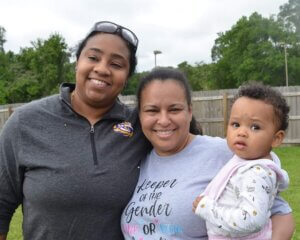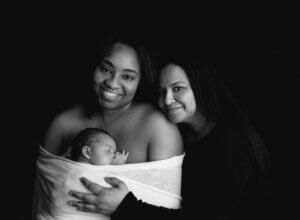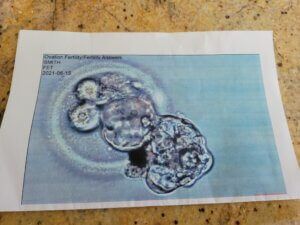Couple’s patience pays off after long, five-year fertility journey

Ashanti and Bianca began their journey to bringing a child together into this world in 2017. Little did they know it would take over 5 years to make their dream a reality. Throughout their long journey, they experienced the highest of the highs and the lowest of the lows. But through it all, they stuck with their plan and stuck together so that they could one day be called “Mom.”
LGBT couple would require medical assistance to conceive
Introduced by a mutual friend and married not long after meeting, these two Lafayette-based professional women shared a dream of one day being moms. “We’ve both always wanted to be parents,” says Ashanti. “We discussed it early on in our relationship and we both knew we would do what it took for it to become reality.” Ashanti, a family practice physician, and Bianca, a civil defense lawyer, have high aspirations in both their private and professional lives and soon after their marriage they started down the path of becoming parents together.
As a same-sex couple, Ashanti and Bianca knew they would need some medical help in order to become the parents they longed to be. They discussed their options with Dr. John Storment at Fertility Answers in the spring of 2017 who recommended they start with an intrauterine insemination using donor sperm. Ashanti volunteered to be the one to try to get pregnant since she was in her early 30s and 6 years younger than Bianca. But their busy professional lives interfered with their plans to get started right away. “I was knee-deep in the middle of my family practice residency at LSU at the time, and working so much,” remembers Ashanti. “It took us almost a year to find a break in our busy lives to pick the right sperm donor and to schedule the insemination.”
Their journey proves to not be as easy as imagined

However, right before their scheduled IUI procedure, Dr. Storment cancelled it when cysts were found on both of Ashanti’s ovaries with blockage also on the right fallopian tube. Out-patient surgery removed the cysts, but with blockage still on the right tube, the couple decided to instead move forward with in vitro fertilization which they felt would give them a better chance of success. However, they would now need to wait several months to let Ashanti’s body heal and to again find the right time in their schedules.
Finally, in the fall of 2018, Ashanti began to prep her ovaries for an egg retrieval with the goal to get as many mature eggs as they could for IVF. Their egg retrieval was a great success with 14 eggs retrieved, six of which fertilized. Ultimately, they ended up with four normal, euploid embryos after preimplantation genetic testing.
Ashanti and Bianca, excited about having four embryos to work with, planned a December transfer. But, a few weeks after her retrieval while Ashanti was working in the emergency room, a patient who had overdosed on opioids vomited in her face. Because the patient was positive for hepatitis-C, Ashanti would have to delay the embryo transfer until her infectious disease doctor cleared her negative for the virus. This would require at least four months of testing and waiting.
Finally, after months of testing and anxiety about being possibly infected with hepatitis-C, Ashanti tested negative to a sigh of relief. They quickly moved forward with an embryo transfer in May 2019. Soon after, they found out the embryo had implanted, and Ashanti was pregnant. But their joy soon turned to despair when Ashanti’s water broke at 20 weeks pregnant. She was immediately put on bedrest to try to save the baby. Unfortunately, she delivered their sweet angel not long after, born too premature to survive.
Trying again after the lowest of the lows

Ashanti and Bianca were heartbroken. By the beginning of 2020, they finally felt emotionally ready to begin the process again after losing their baby. With three embryos remaining, they began preparing for a March 2020 embryo transfer. Then the Covid-19 pandemic happened and the state, as well as the whole world, literally shut down. “We just felt like we couldn’t catch a break,” remembers Bianca. Already they were three years into their journey and still no baby.
As the state began loosening up restrictions on medical procedures after the pandemic, Ashanti and Bianca rescheduled their transfer for May 2020. But this go around the embryo did not implant, and Ashanti was not pregnant. They had two more transfers scheduled for September 2020 and then January 2021, but both of these ended up cancelled when Ashanti’s response with pre-transfer medications to the first was too low and the second too high.
The couple was rightfully disappointed with all of their setbacks and transfer cancellations. “At this point, we just needed to take a break,” says Ashanti.
After a few months to regroup, they decided to do another embryo transfer in May 2021, this time adjusting Ashanti’s medications. Two weeks later, they were elated when Ashanti was again pregnant. And after a thankfully uneventful pregnancy this time, Audrey Chandler was born in February 2022, approximately five years after their journey to a baby began. They both credit the staff at Fertility Answers for keeping their spirits high. “Everyone at Fertility Answers was rooting for us,” says Bianca. “They were all so nice and supportive throughout this long journey of ours. We felt the love and support every time we were there.”
Ashanti and Bianca absolutely love being parents. “It’s exhausting, especially with me as an older parent, but we love every minute of life with Chandler,” says Bianca. “She was definitely worth all the highs and lows that came with this journey.”
The couple still has one euploid embryo to use and have plans to do a final embryo transfer this summer. “This whole journey was such a long process, but we would love to give Audrey a sibling,” says Ashanti. Their friends at Fertility Answers will be right along with them cheering them on.


